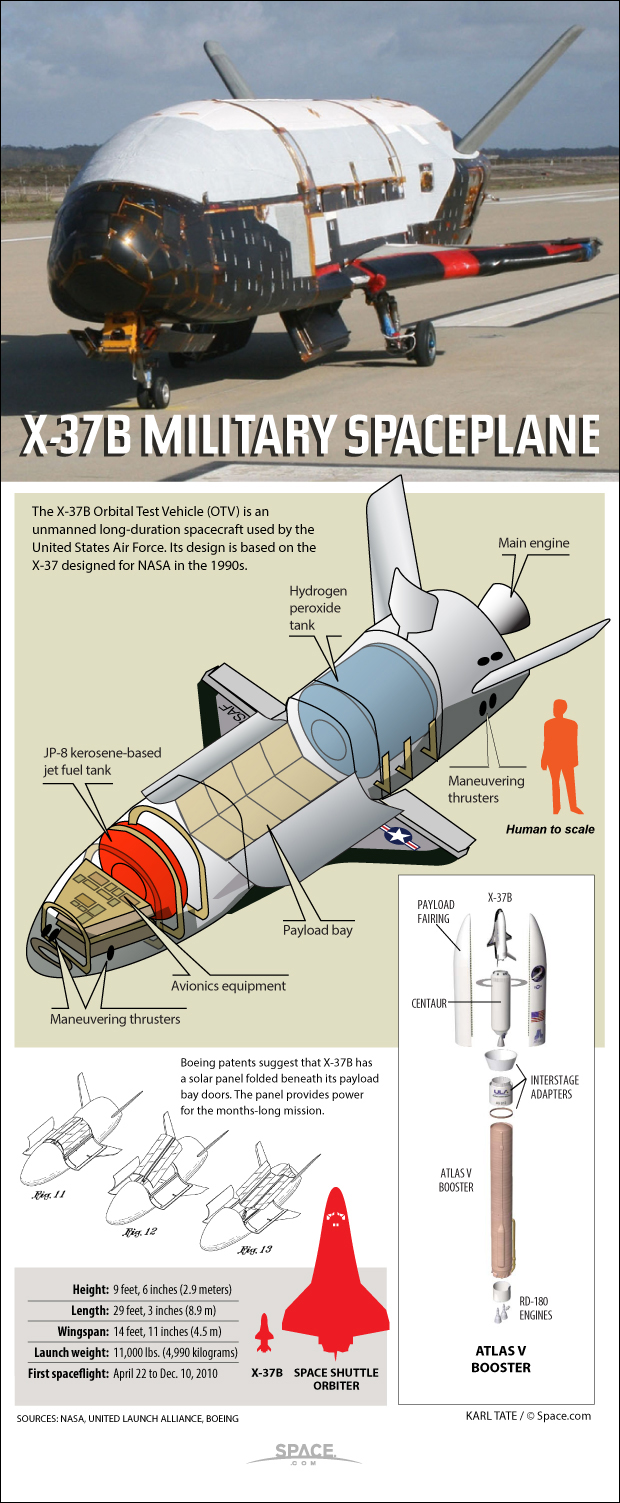SpaceX to Launch Air Force's X-37B Space Plane on Secret Mission Today: Watch Live
The U.S. Air Force's secretive X-37B space plane is set to launch on its fifth classified mission today — the only question is exactly when.
Weather permitting, the space plane will lift off aboard a SpaceX Falcon 9 rocket from Kennedy Space Center in Florida sometime between 9:50 a.m. EDT and 2:55 p.m. EDT (1350-1855 GMT), and you can watch the launch live online.
SpaceX will broadcast the launch live, and you can also watch it live on Space.com, courtesy of SpaceX. But the launch window spans hours, and the webcast will start just 10 minutes before the launch — so stay on your toes. Shortly after the launch, the Falcon 9's first stage will land SpaceX's Landing Zone 1 at the nearby Cape Canaveral Air Force Station. [The Mysterious X-37B Space Plane: 6 Surprising Facts]


This flight marks SpaceX's second military launch; in May, a Falcon rocket carried a classified spy satellite into orbit for the Department of Defense.
The Air Force's 45th Space Wing posted an airspace closure advisory spanning a slightly more than a 5-hour window for launch.
Of course, this launch all depends on the weather. According to SpaceNews, the weather is 50 percent "go" for a launch tomorrow but will grow increasingly worse over the following days as Hurricane Irma approaches the area. If SpaceX is unable to launch the X-37B today, it has a backup launch day of Sept. 8.
Though Irma will be 950 miles southeast of the spaceport and won't affect a Thursday launch, a schedule slip to Friday could mean winds of up to 20 mph (32 km/h) by the end of the launch window, Emre Kelly reported for Florida Today.
Breaking space news, the latest updates on rocket launches, skywatching events and more!
X-37B space plane also called the Orbital Test Vehicle (OTV), is one of two known reusable vehicles in the military fleet.
"The fifth OTV mission continues to advance the X-37B's performance and flexibility as a space technology demonstrator and host platform for experimental payloads," Air Force officials said in a statement. "This mission carries small satellite ride shares and will demonstrate greater opportunities for rapid space access and on-orbit testing of emerging space technologies."
They added that the mission will host a payload to test experimental electronics and oscillating heat pipe technologies for use in long-duration missions. It will also be launched into, and landed from, a higher-inclination orbit than in previous missions.
The robotic minishuttle is no stranger to civilian uncertainty; the last X-37B mission finally landed May 7 after 718 days in space, with no prior warning. Each of the four OTV missions, starting in 2010, has stayed in space longer than the previous one.
So there are a few question marks with this mission: Not only are the precise launch time and details of the mission nebulous, but the landing date is also uncertain — although it's safe to guess it won't be anytime soon.
Email Sarah Lewin at slewin@space.com or follow her @SarahExplains. Follow us @Spacedotcom, Facebook and Google+. Original article on Space.com.
Join our Space Forums to keep talking space on the latest missions, night sky and more! And if you have a news tip, correction or comment, let us know at: community@space.com.

Sarah Lewin started writing for Space.com in June of 2015 as a Staff Writer and became Associate Editor in 2019 . Her work has been featured by Scientific American, IEEE Spectrum, Quanta Magazine, Wired, The Scientist, Science Friday and WGBH's Inside NOVA. Sarah has an MA from NYU's Science, Health and Environmental Reporting Program and an AB in mathematics from Brown University. When not writing, reading or thinking about space, Sarah enjoys musical theatre and mathematical papercraft. She is currently Assistant News Editor at Scientific American. You can follow her on Twitter @SarahExplains.
